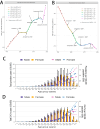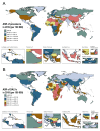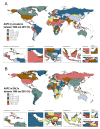Global prevalence and disability-adjusted life years of hypertensive heart disease: A trend analysis from the Global Burden of Disease Study 2019
- PMID: 39212657
- PMCID: PMC11364089
- DOI: 10.7189/jogh.14.04172
Global prevalence and disability-adjusted life years of hypertensive heart disease: A trend analysis from the Global Burden of Disease Study 2019
Abstract
Background: As hypertensive heart disease (HHD) presents a significant public health challenge globally, we analysed its global, regional, and national burdens and trends from 1990 to 2019.
Methods: We used data from the Global Burden of Disease (GBD) 2019 study, focussing on the age-standardised prevalence rates (ASPRs) of HHD prevalence, age-standardised disability-adjusted life year (DALY) rates, average annual percentage change (AAPC), and risk factor attributions. We compared the HHD burden across sociodemographic index (SDI) strata, gender, age groups, and 204 countries and territories.
Results: In 2019, the global prevalence of HHD was estimated at 18 598 thousand cases, with DALYs reaching 21 508 thousand. From 1990 to 2019, the ASPRs increased (AAPC = 0.21; 95% confidence interval (CI) = 0.17, 0.24), while the age-standardised DALY rates decreased (AAPC = -0.45; 95% CI = -1.23, -0.93). We observed the highest increase in ASPRs in high-middle SDI quantile countries, and an overall negative correlation between age-standardised DALY rates and SDI. Individuals above 70 years of age were the most affected, particularly elderly women. There has been a significant increase in HHD burden attributed to high body mass index (BMI) since 1990. The burden of HHD is concentrated in the middle SDI quintile, with population ageing and growth being major drivers for the increase in DALYs. We identified opportunities for reducing age-standardised DALY rates in the middle SDI quintile or lower.
Conclusion: Despite a declining trend in the age-standardised DALY rates, the ASPRs of HHD continue to rise, especially in high-middle SDI regions. Meanwhile, countries in middle and lower SDI quintiles face a higher burden of age-standardised DALY rates. Targeted attention towards elderly women and controlling high BMI, alongside enhancing hypertension and HHD management awareness, is crucial for reducing the global burden of HHD.
Copyright © 2024 by the Journal of Global Health. All rights reserved.
Conflict of interest statement
Disclosure of interest: The authors completed the ICMJE Disclosure of Interest Form (available upon request from the corresponding author) and disclose no relevant interests.
Figures





References
-
- GBD 2016 Risk Factors Collaborators Global, regional, and national comparative risk assessment of 84 behavioural, environmental and occupational, and metabolic risks or clusters of risks, 1990-2016: a systematic analysis for the Global Burden of Disease Study 2016. Lancet. 2017;390:1345–422. 10.1016/S0140-6736(17)32366-8 - DOI - PMC - PubMed
MeSH terms
LinkOut - more resources
Full Text Sources
Medical
Research Materials
